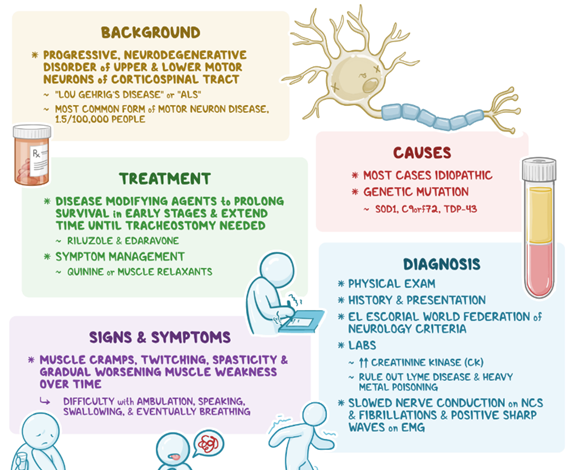A patient with Parkinson's disease asks the nurse why anticholinergics are used in the treatment. Which response by the nurse is most accurate?
"These drugs inhibit the action of acetylcholine
"These drugs help you urinate."
"These drugs will decrease your eye pressure."
"These drugs will assist in lowering your heart rate."
The Correct Answer is A
A. "These drugs inhibit the action of acetylcholine":
This response is accurate. Anticholinergic medications work by blocking the action of acetylcholine, a neurotransmitter involved in various functions in the body, including muscle control. In Parkinson's disease, there is an imbalance between dopamine and acetylcholine, leading to motor symptoms such as tremors and rigidity. By inhibiting the action of acetylcholine, anticholinergic drugs help rebalance neurotransmitter activity and alleviate some of the motor symptoms associated with Parkinson's disease.
B. "These drugs help you urinate":
This statement is not directly related to the use of anticholinergic medications in Parkinson's disease. While some anticholinergic drugs can indeed relax the smooth muscle of the bladder and improve urinary symptoms, this is not the primary indication for their use in Parkinson's disease.
C. "These drugs will decrease your eye pressure":
While anticholinergic medications can be used to dilate the pupils and decrease intraocular pressure, this is not typically the reason for their use in Parkinson's disease. While some anticholinergic medications may have ocular effects, they are primarily used to address motor symptoms associated with Parkinson's disease.
D. "These drugs will assist in lowering your heart rate":
While some anticholinergic medications may have effects on heart rate by blocking parasympathetic nervous system activity, this is not the primary indication for their use in Parkinson's disease. The focus of anticholinergic therapy in Parkinson's disease is primarily on addressing motor symptoms rather than cardiovascular effects.
Nursing Test Bank
Naxlex Comprehensive Predictor Exams
Related Questions
Correct Answer is B
Explanation
A. Intellectual capacity is not affected:
This statement refers to the fact that ALS primarily affects motor neurons, leading to muscle weakness and paralysis, but it typically does not directly impact cognitive function or intellectual capacity. While cognitive impairment is not a hallmark feature of ALS, some individuals may experience changes in cognitive function or behavior, such as executive dysfunction or frontotemporal dementia, in later stages of the disease. However, depression in ALS is not primarily linked to changes in intellectual capacity but rather to other factors such as altered communication, physical limitations, and loss of autonomy.
B. Communication is altered:
ALS can affect the muscles involved in speech and swallowing, leading to difficulties in communicationAs the disease progresses, patients may experience dysarthria (difficulty speaking clearly) and dysphagia (difficulty swallowing), which can impair their ability to communicate effectively with others. Altered communication can result in frustration, social isolation, and feelings of being misunderstood, all of which are risk factors for depression.
C. Mobility is limited:
ALS causes progressive muscle weakness and paralysis, which can significantly impair mobility over time. As the disease advances, individuals with ALS may become increasingly dependent on mobility aids such as wheelchairs or may require assistance with mobility tasks. Limited mobility can lead to feelings of loss of independence, decreased participation in activities, and increased dependence on caregivers, all of which can contribute to depression.
D. Nutritional intake is poor:
ALS can affect the muscles involved in swallowing and chewing, leading to difficulties with eating and drinking. Dysphagia, or difficulty swallowing, is a common symptom in ALS and can result in poor nutritional intake and weight loss. Malnutrition and weight loss are associated with increased morbidity and mortality in ALS, and they can also contribute to feelings of weakness, fatigue, and overall decline in quality of life, which may exacerbate depression.

Correct Answer is C
Explanation
A. "I will notify my provider before taking any other medications."
This statement demonstrates understanding of the importance of consulting the provider before taking any other medications. It is correct because phenytoin may interact with other drugs, so notifying the provider is essential to avoid potential interactions.
B. "I have made an appointment to see my dentist next week."
This statement indicates that the client understands the importance of dental care while taking phenytoin. Phenytoin can cause gum overgrowth (gingival hyperplasia), so regular dental check-ups are recommended to monitor oral health. This statement is correct.
C. "I will take this medication with meals."
This statement suggests that the client plans to take phenytoin with meals. However, phenytoin should generally be taken on an empty stomach to enhance absorption, unless gastrointestinal upset occurs. Therefore, this statement indicates a need for further teaching.
D. "I'll be glad when my seizures stop so I can quit taking this medicine."
This statement reflects a misconception about the management of epilepsy. Phenytoin is typically used as a long-term treatment to prevent seizures, not as a short-term solution to stop seizures. Therefore, this statement indicates a need for further education about the chronic nature of epilepsy and the need for ongoing medication adherence.
E. “I’ll take this medication before meals.”
This statement correctly indicates the timing of phenytoin administration before meals. Taking phenytoin before meals helps enhance absorption and minimize the risk of gastrointestinal side effects. Therefore, this statement is correct.
Whether you are a student looking to ace your exams or a practicing nurse seeking to enhance your expertise , our nursing education contents will empower you with the confidence and competence to make a difference in the lives of patients and become a respected leader in the healthcare field.
Visit Naxlex, invest in your future and unlock endless possibilities with our unparalleled nursing education contents today
Report Wrong Answer on the Current Question
Do you disagree with the answer? If yes, what is your expected answer? Explain.
Kindly be descriptive with the issue you are facing.
